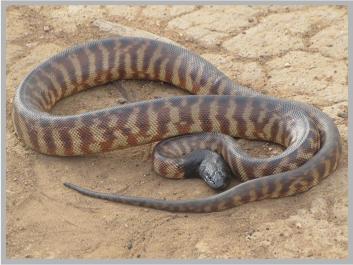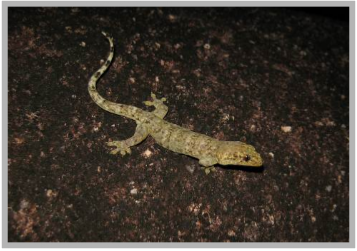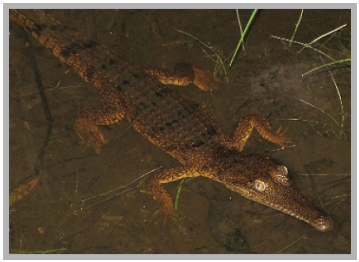

HOME | ABOUT US | HOMELANDS DEVELOPMENT | NRM | CULTURAL HERITAGE | PROJECTS | CAMPGROUNDS | MEDIA | LINKS

HOME | ABOUT US | HOMELANDS DEVELOPMENT | NRM | CULTURAL HERITAGE | PROJECTS | CAMPGROUNDS | MEDIA | LINKS




In 2009-10 Chuulangun Aboriginal Corporation conducted an inventory survey of the fauna of the Kaanju Ngaachi IPA with the assistance of a grant from the PEW Environment Group and biologist Simon Kennedy. To request a copy of the survey report please contact Chuulangun Aboriginal Corporation. To view Kuuku I'yu Northern Kaanju Traditional Custodian David Claudie talking about the survey click here.
Over the 18 months of the project a total of 263 native species were recorded, including 46 species of mammals, 140 species of birds, 25 species of amphibians and 52 species of reptiles. Of these, 15 are listed under state threatened species legislation, four are nationally and one globally threatened.
Significant fauna records include:
o A population of a frog of the genus Cophixalus that is either the second population of a recently discovered and still undescribed species, or a new discovery to western science. The population was found in a granite boulderfield near the Pascoe River.
o The nationally Endangered Semon's Leaf-nosed Bat at several locations. This cave-roosting species is declining northwards in Australia.
o The nationally Endangered Large-eared and Intermediate Horseshoe Bats. There is likely to be at least two roosts of both of these cave-roosting s pecies in the IPA. These two bats were thought to be a single species until recently.
o A population of the little-known Cape York Rock-wallaby (listed as Near Threatened globally). This species was photographed in the wild for the first time during the survey by Chuulangun Rangers Sheanine Claudie and Farron Port.
o Two bat species listed as Vulnerable in Queensland, the Fawn Leaf-nosed Bat and Coastal Sheathtail Bat. The Coastal Sheathtail Bat is rarely found this far inland.
o An undescribed gecko of the genus Gehyra in gallery rainforest and vine-thickets.
o Numerous records of two rainbow skinks globally endemic to Cape York, the Coen Rainbow-skink and Crevice Rainbow-skink on granite outcrops with vine-thickets.
o A sighting of Iwayi (Estuarine Crocodile) in a lagoon near the Wenlock River. They are also known to occur on the Pascoe River within the IPA.
o Records of the Yitha (Yellow-spotted Monitor) and Muutha (Mertens' Water Monitor), which are both moderately common on Kaanju Ngaachi. These two goannas are susceptible to poisoning from eating Cane Toads and have rapidly declined over much of northern Australia.
o Seven species listed as Near-Threatened in Queensland, including four birds (Rufous Owl, Kila (Palm Cockatoo), Australian Swiftlet and Marshall's Fig-parrot) and three mammals (Papuan Sheathtail Bat, Bare-backed Fruit-bat and Cape York Rock-wallaby).
o Some of the most southerly records ever recorded for the Papuan Sheathtail Bat.
o Records of two bird species globally endemic to Cape York; the White-streaked Honeyeater was recorded several times, usually in gallery rainforest, and the Frill-necked Monarch was recorded in rainforest at several locations.
o Several species only found on Cape York Peninsula within Australia (but also found in New Guinea), including the Magnificent Riflebird (Ptiloris magnificus), Kila (Palm Cockatoo), Trumpet Manucode (Manucodia keraudrenii), Fawn Leaf-nosed Bat, Papuan Sheathtail Bat and Red-cheeked Parrot.
The survey also found that the outcropping rocks associated with vine-thickets are a refuge for a number of bioregional endemics. The gallery rainforests had the highest bird species richness and act as corridors for at least 50 species, while the nearby lagoon systems had the highest frog richness and abundance. The eucalypt and paperbark savannas each had distinct faunas including several Near-threatened and localised species. Fire management is particularly important in the savannas and may be important around the scattered and isolated vine-thickets and the well-developed but fragile gallery rainforests. Feral animal control is especially important in the lagoon systems and gallery rainforests.
Threatened and declining fauna
A total of 15 species (eight mammals, five birds and a reptile) were found that are listed under State legislation. The Red Goshawk is one of Australia's rarest birds of prey. The extensive uncleared savannas and gallery rainforests of this area are ideal habitat for this species, which is reported to have one of the largest home ranges of any bird of prey, around 20 000 hectares. If this is accurate for this area, then only a few pairs are likely to occur in a protected area even of this size. It is often, though not always in areas with mountains and gorges. Another Red Goshawk was seen near the Wenlock River just west of the IPA in 2010.
The Semon's Leaf-nosed Bat is Endangered in Australia and is said to be declining northward and within the Iron Range National Park. Finding and protecting roost sites is important, and there are likely to be at least two in the IPA, with the gallery rainforests of the Wenlock River and the vine thickets and rainforests on Mount Bowden (northern IPA) likely areas of importance.
The cave-dwelling Large-eared Horseshoe Bat is likely to have roost sites within granite country, as they were recorded calling in that area. The Intermediate Horseshoe Bat by contrast was recorded from gallery rainforests and lagoon areas, although its roosts are also likely to be in natural overhangs and caves in upland (Kaanichi areas), with the bats foraging near Sefton Creek possibly roosting in the mountainous area to the east. Whether this difference in foraging habits is an artefact of a small number of records or a clue as to the way these bats co-exist requires further study.
The Fawn Leaf-nosed Bat is only found in Australia on Cape York Peninsula (and also in countries to the north). Like its cousin the Semon's Leaf-nosed Bat it forages slowly low to the ground and roosts in caves and old mineshafts. It is widespread within the IPA. Coastal Sheathtail Bats are unique in Australia for their strong preference for coastal areas, even islands for roost sites (Menkhorst and Knight 2004). It was surprising to record them as far inland as the IPA, where they were found roosting among granite boulders about 38 km from the nearest shoreline. Further work on this species will require field searches as the call of this species is difficult to identify from bats with similar calls.
The Cape York Rock-wallaby (Petrogale coensis) is so little known that prior to this study it had never been photographed. Sightings by David Claudie and Eric Vanderduys (CSIRO) prompted a number of visits to the black granite country on the Northern Kaanju Ngaachi. In November 2009 a group of Chuulangun Rangers and Simon Kennedy searched granite tors and outcropping granite boulders as well as larger boulderfields. A number of Rock-wallabies were seen and two were photogrpahed by Chuulangun rangers Farron Port anf Sheanine Claudie.
Bioregional endemic fauna
Thirteen species endemic to the Cape York bioregion were recorded during the survey. This includes three undescribed species, which are almost certainly (in the case of Cophixalus sp.) and probably (Gehyra sp. and Rhinolophus sp. nov.), endemic to the Cape York bioregion. Of these species, four are kaanichi boulderfield/vine-thicket specialists, another probably roosts in these areas and another (Gehyra sp.) was most common in these habitats but was also found in gallery rainforests. Two were found in gallery rainforest but may be present in Kaanichi rainforests of the eastern IPA, and a third was found in Kaanichi and Paakichi rainforest.
Over the 18 months of the project a total of 263 native species were recorded, including 46 species of mammals, 140 species of birds, 25 species of amphibians and 52 species of reptiles. Of these, 15 are listed under state threatened species legislation, four are nationally and one globally threatened.
Significant fauna records include:
o A population of a frog of the genus Cophixalus that is either the second population of a recently discovered and still undescribed species, or a new discovery to western science. The population was found in a granite boulderfield near the Pascoe River.
o The nationally Endangered Semon's Leaf-nosed Bat at several locations. This cave-roosting species is declining northwards in Australia.
o The nationally Endangered Large-eared and Intermediate Horseshoe Bats. There is likely to be at least two roosts of both of these cave-roosting s pecies in the IPA. These two bats were thought to be a single species until recently.
o A population of the little-known Cape York Rock-wallaby (listed as Near Threatened globally). This species was photographed in the wild for the first time during the survey by Chuulangun Rangers Sheanine Claudie and Farron Port.
o Two bat species listed as Vulnerable in Queensland, the Fawn Leaf-nosed Bat and Coastal Sheathtail Bat. The Coastal Sheathtail Bat is rarely found this far inland.
o An undescribed gecko of the genus Gehyra in gallery rainforest and vine-thickets.
o Numerous records of two rainbow skinks globally endemic to Cape York, the Coen Rainbow-skink and Crevice Rainbow-skink on granite outcrops with vine-thickets.
o A sighting of Iwayi (Estuarine Crocodile) in a lagoon near the Wenlock River. They are also known to occur on the Pascoe River within the IPA.
o Records of the Yitha (Yellow-spotted Monitor) and Muutha (Mertens' Water Monitor), which are both moderately common on Kaanju Ngaachi. These two goannas are susceptible to poisoning from eating Cane Toads and have rapidly declined over much of northern Australia.
o Seven species listed as Near-Threatened in Queensland, including four birds (Rufous Owl, Kila (Palm Cockatoo), Australian Swiftlet and Marshall's Fig-parrot) and three mammals (Papuan Sheathtail Bat, Bare-backed Fruit-bat and Cape York Rock-wallaby).
o Some of the most southerly records ever recorded for the Papuan Sheathtail Bat.
o Records of two bird species globally endemic to Cape York; the White-streaked Honeyeater was recorded several times, usually in gallery rainforest, and the Frill-necked Monarch was recorded in rainforest at several locations.
o Several species only found on Cape York Peninsula within Australia (but also found in New Guinea), including the Magnificent Riflebird (Ptiloris magnificus), Kila (Palm Cockatoo), Trumpet Manucode (Manucodia keraudrenii), Fawn Leaf-nosed Bat, Papuan Sheathtail Bat and Red-cheeked Parrot.
The survey also found that the outcropping rocks associated with vine-thickets are a refuge for a number of bioregional endemics. The gallery rainforests had the highest bird species richness and act as corridors for at least 50 species, while the nearby lagoon systems had the highest frog richness and abundance. The eucalypt and paperbark savannas each had distinct faunas including several Near-threatened and localised species. Fire management is particularly important in the savannas and may be important around the scattered and isolated vine-thickets and the well-developed but fragile gallery rainforests. Feral animal control is especially important in the lagoon systems and gallery rainforests.
Threatened and declining fauna
A total of 15 species (eight mammals, five birds and a reptile) were found that are listed under State legislation. The Red Goshawk is one of Australia's rarest birds of prey. The extensive uncleared savannas and gallery rainforests of this area are ideal habitat for this species, which is reported to have one of the largest home ranges of any bird of prey, around 20 000 hectares. If this is accurate for this area, then only a few pairs are likely to occur in a protected area even of this size. It is often, though not always in areas with mountains and gorges. Another Red Goshawk was seen near the Wenlock River just west of the IPA in 2010.
The Semon's Leaf-nosed Bat is Endangered in Australia and is said to be declining northward and within the Iron Range National Park. Finding and protecting roost sites is important, and there are likely to be at least two in the IPA, with the gallery rainforests of the Wenlock River and the vine thickets and rainforests on Mount Bowden (northern IPA) likely areas of importance.
The cave-dwelling Large-eared Horseshoe Bat is likely to have roost sites within granite country, as they were recorded calling in that area. The Intermediate Horseshoe Bat by contrast was recorded from gallery rainforests and lagoon areas, although its roosts are also likely to be in natural overhangs and caves in upland (Kaanichi areas), with the bats foraging near Sefton Creek possibly roosting in the mountainous area to the east. Whether this difference in foraging habits is an artefact of a small number of records or a clue as to the way these bats co-exist requires further study.
The Fawn Leaf-nosed Bat is only found in Australia on Cape York Peninsula (and also in countries to the north). Like its cousin the Semon's Leaf-nosed Bat it forages slowly low to the ground and roosts in caves and old mineshafts. It is widespread within the IPA. Coastal Sheathtail Bats are unique in Australia for their strong preference for coastal areas, even islands for roost sites (Menkhorst and Knight 2004). It was surprising to record them as far inland as the IPA, where they were found roosting among granite boulders about 38 km from the nearest shoreline. Further work on this species will require field searches as the call of this species is difficult to identify from bats with similar calls.
The Cape York Rock-wallaby (Petrogale coensis) is so little known that prior to this study it had never been photographed. Sightings by David Claudie and Eric Vanderduys (CSIRO) prompted a number of visits to the black granite country on the Northern Kaanju Ngaachi. In November 2009 a group of Chuulangun Rangers and Simon Kennedy searched granite tors and outcropping granite boulders as well as larger boulderfields. A number of Rock-wallabies were seen and two were photogrpahed by Chuulangun rangers Farron Port anf Sheanine Claudie.
Bioregional endemic fauna
Thirteen species endemic to the Cape York bioregion were recorded during the survey. This includes three undescribed species, which are almost certainly (in the case of Cophixalus sp.) and probably (Gehyra sp. and Rhinolophus sp. nov.), endemic to the Cape York bioregion. Of these species, four are kaanichi boulderfield/vine-thicket specialists, another probably roosts in these areas and another (Gehyra sp.) was most common in these habitats but was also found in gallery rainforests. Two were found in gallery rainforest but may be present in Kaanichi rainforests of the eastern IPA, and a third was found in Kaanichi and Paakichi rainforest.
HOME | ABOUT US | HOMELANDS DEVELOPMENT | NRM | CULTURAL HERITAGE | PROJECTS | CAMPGROUNDS | MEDIA | LINKS
HOME | ABOUT US | HOMELANDS DEVELOPMENT | NRM | CULTURAL HERITAGE | PROJECTS | CAMPGROUNDS | MEDIA | LINKS


Copyright 2003-15 by Chuulangun Aboriginal Corporation | ABN 74277585078 | Contact Us | Credits | Disclaimer | This page last updated 16/06/15








